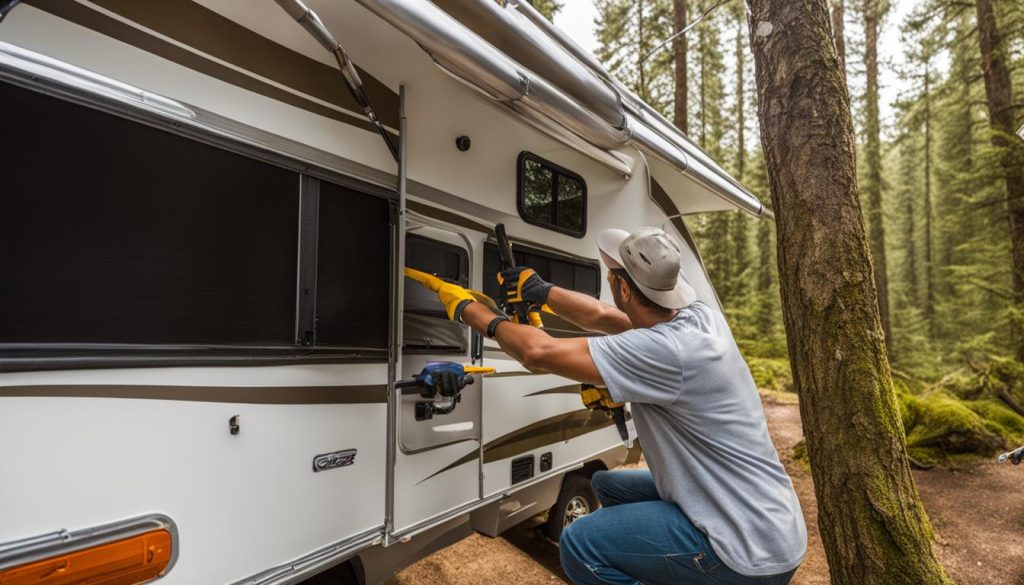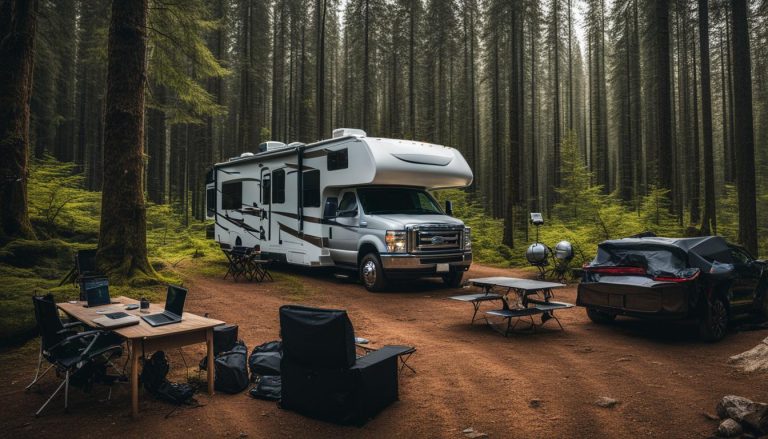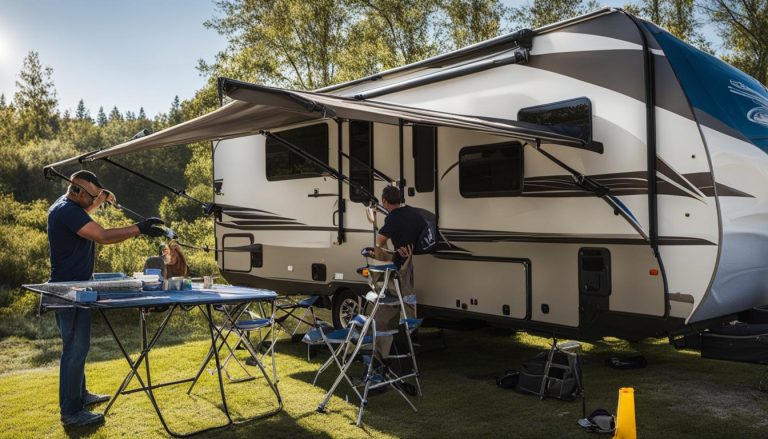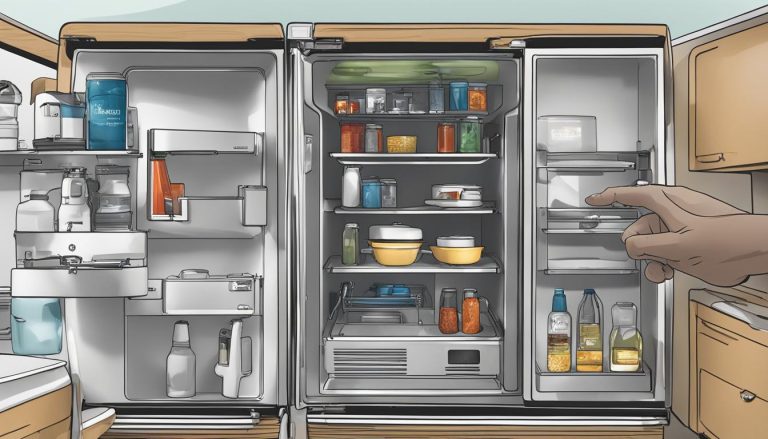Keep Rodents Out of Your RV: Safe & Simple Tips
gorvlifestyle.com and its partners may earn a commission if you purchase a product through one of our links
Mice can cause significant damage to your RV, chewing through wiring and plumbing systems, and even spreading diseases. Understanding why mice target campers and recognizing the signs of a mouse infestation is crucial in protecting your motorhome.
Mice are drawn to campers because they offer warmth and comfort in their search for shelter. However, with the right preventive measures, you can keep rodents out of your RV and enjoy a worry-free camping experience.
Key Takeaways:
- Inspect and seal potential entry points in your RV to prevent mice from getting inside.
- Use natural and electronic deterrents and repellents to keep mice away from your camper.
- Maintain a clean RV and store food properly to minimize the risk of attracting mice.
- Take prompt action in case of a mouse infestation to eliminate them effectively and avoid future problems.
- Regularly clean and maintain your camper to create an inhospitable environment for mice.
Understanding Why Mice Target Campers
Mice are attracted to campers for several reasons. By understanding these factors, you can take proactive measures to deter them and protect your camper from potential damage.
Warmth and Shelter
Campers provide mice with a warm and safe environment. When the temperatures drop, mice seek sheltered spaces to escape the cold. Campers offer insulation and cozy areas that attract mice looking for protection from the elements.
Abundance of Food
Campers often contain an abundance of food sources that lure mice. Bits of leftover snacks, crumbs, and food spills can be attractive to hungry mice. They can easily access these food sources and establish nests nearby, taking advantage of the readily available sustenance.
Nesting Materials
Mice build nests using various materials found within the camper. From insulation to fabrics, they utilize these resources to create comfortable nests for breeding and raising their young. The presence of easily accessible nesting materials inside the camper makes it an appealing target for mice.
Damage to Wiring and Plumbing
Mice have a habit of chewing on wires and other materials, including plumbing systems. This behavior can lead to costly repairs and potential safety hazards. Campers often have hidden wiring and plumbing, making them vulnerable to mouse infestations and the resulting damage.
“Understanding why mice target campers is the first step in implementing effective strategies to keep them at bay.”
Implementing measures to address these attraction factors is essential in preventing mouse infestations and protecting your camper. In the next section, we will discuss the signs of a mouse infestation, helping you detect and address the problem promptly.
Signs of a Mouse Infestation
Recognizing the signs of a mouse infestation is crucial in addressing the problem promptly. By being aware of the indications of a mouse infestation, you can take proactive measures to prevent further damage to your RV. Here are some key signs to watch out for:
- Droppings: Mouse droppings are small, dark, and pellet-shaped. You may find them in areas such as cabinets, drawers, and near food storage areas.
- Gnaw Marks: Mice have a habit of gnawing on various materials to wear down their teeth. Look for gnaw marks on wires, insulation, and furniture.
- Strange Noises: If you hear scratching, scampering, or squeaking sounds coming from within your RV, it may be a sign of mice.
- Musky Odor: A musky smell can indicate a mouse infestation, especially if a mouse has died within your camper.
By being vigilant and observant, you can quickly detect a mouse infestation and take appropriate action to mitigate the problem. Now, let’s explore how to inspect and seal potential entry points in your RV camper to prevent mice from entering.
Inspecting and Sealing Your RV Camper
One of the most effective ways to prevent mice from entering your camper is by thoroughly inspecting and sealing potential entry points. By identifying and sealing these access areas, you can greatly reduce the chances of mice finding their way into your RV.
Examining the Exterior
Start by inspecting the exterior of your RV for any gaps or openings that mice could use to enter. Common areas to pay attention to include:
- Areas where wires enter the RV
- Gaps around pipes and plumbing
- Vents and air conditioning units
Using materials like spray foam, caulk, or steel wool, seal these potential entry points. Ensure a tight seal to prevent any gaps that mice can squeeze through.
Checking the Interior
Next, move inside your RV and inspect for any openings or cracks that mice can exploit. Focus on areas where wires, pipes, or other conduits pass through the RV’s design. These areas are often vulnerable points of entry for mice.
Note: Mice can fit through incredibly small openings, so be thorough in your inspection.
Seal these interior entry points using the same materials as mentioned before. Make sure to cover any gaps or cracks that may provide access to mice.
Regularly inspecting and sealing your RV camper is crucial in preventing mice from entering. By being proactive and addressing potential entry points, you can protect your camper and enjoy rodent-free travels.

| Areas to Inspect and Seal | Materials for Sealing |
|---|---|
| Exterior | Spray foam, caulk, steel wool |
| Interior | Spray foam, caulk, steel wool |
Deterrents and Repellents
When it comes to keeping mice away from your camper, using deterrents and repellents can be an effective strategy. Whether you prefer natural options or electronic devices, there are various solutions available to suit your needs.
Natural Mouse Repellents
One way to repel mice naturally is by using peppermint oil-soaked cotton balls. Mice find the scent of peppermint oil overwhelming and will avoid areas where it is present. Simply soak cotton balls in peppermint oil and place them strategically around your camper, focusing on entry points and areas where mice are likely to hide.
Dryer sheets can also be used as a natural mouse repellent. The strong aroma of dryer sheets masks the scents that attract mice and can discourage them from entering your camper. Place dryer sheets in cabinets, storage compartments, and any other areas where mice may try to gain access.
Another natural option is Fresh Cab pouches. These pouches are filled with a blend of botanical ingredients that emit a scent mice find repulsive. You can hang or place Fresh Cab pouches in areas where mice are likely to enter or nest, such as near doors, windows, or vents.
Electronic Mouse Repellents
If you prefer a hands-off approach, electronic mouse repellents can be a convenient option. These devices emit high-frequency sound waves that are unpleasant to mice but inaudible to humans. Simply plug in or place electronic repellents near areas where mice are likely to enter, such as power outlets, and let them do the work.
There are also solar-powered electronic repellents available, which harness the power of the sun to emit ultrasonic waves. These devices are great for outdoor use, such as around your camper or in camping areas.
Choosing the Right Deterrents and Repellents
When selecting deterrents and repellents for your camper, it’s important to consider your specific needs and preferences. Natural options may be ideal if you prefer eco-friendly solutions or have concerns about using electronic devices. Electronic repellents, on the other hand, offer a hassle-free and continuous method of keeping mice at bay.
| Deterrent/Repellent | Effectiveness | Ease of Use | Environmentally Friendly |
|---|---|---|---|
| Peppermint oil-soaked cotton balls | Effective | Easy | Yes |
| Dryer sheets | Moderate | Easy | Yes |
| Fresh Cab pouches | Effective | Easy | Yes |
| Electronic repellents | Highly effective | Easy | Yes |
| Solar-powered electronic repellents | Moderate to highly effective | Easy | Yes |
Consider using a combination of deterrents and repellents to maximize their effectiveness. For example, you can use peppermint oil-soaked cotton balls along with electronic repellents for a multi-layered approach.

By implementing these deterrents and repellents, you can create an environment that is unappealing to mice, reducing the chances of a mouse infestation in your camper. However, it’s important to remember that no method is foolproof, and regular inspections and maintenance are still necessary to ensure your camper remains mouse-free.
Maintaining a Clean and Mouse-Proof RV
Maintaining a clean and mouse-proof RV is crucial to prevent mice from entering your camper and causing damage. By following a few simple steps, you can significantly reduce the risk of a mouse infestation and ensure a safe and comfortable environment for your travels.
Proper Food Storage
Proper food storage is essential in minimizing the risk of attracting mice to your RV. Store all food items in airtight containers to prevent rodents from detecting and accessing them. Avoid leaving any food out on countertops or tables, as this can easily attract mice. When storing your camper for extended periods, remove all perishable food items to minimize the chances of a mouse invasion.
Clean Up Regularly
Regular cleaning and maintenance are essential in keeping mice at bay. Clean up any food debris, crumbs, or spills promptly. These can serve as a food source and attract pests into your RV. Pay special attention to areas where food is prepared and consumed, such as the kitchen and dining area. Regularly vacuuming and sweeping the floors can also help remove any potential food sources for mice.
Seal Potential Entry Points
“A little time spent sealing up any gaps or holes can save you a lot of trouble down the road.”
Inspect your RV thoroughly for any potential entry points that mice could exploit. Check for gaps around windows, doors, vents, and utility penetrations. Seal any openings with suitable materials such as caulk, expanding foam, or steel wool. This will help prevent mice from entering your RV and finding a cozy nesting spot.
Keep an Organized RV
An organized RV not only makes your camping trips more enjoyable but also deters mice from taking up residence. Cluttered areas provide hiding spots for pests and make it difficult to detect and address any signs of a mouse infestation. Keep your belongings well-organized and stored in containers when possible. This will not only make it easier to maintain a clean and mouse-proof environment but also help you locate and address any mouse-related issues.
Use Natural Deterrents
Consider using natural deterrents to repel mice from your camper. Peppermint oil-soaked cotton balls, dryer sheets, or Fresh Cab pouches can emit scents that mice find unpleasant. Placing these deterrents near potential entry points or in areas where mice are frequently spotted can be effective in keeping them away.
Maintain a Clean Exterior
Don’t forget to maintain the exterior of your RV as well. Clear away any debris, such as leaves or firewood, that could provide hiding spots or nesting materials for mice. Trim back vegetation near your camper to create a buffer zone that discourages pests from approaching. Regularly inspect and clean your RV’s exterior to ensure it remains in good condition and less susceptible to mouse infestations.
| Benefits of Maintaining a Clean and Mouse-Proof RV |
|---|
| Prevents damage to wiring and plumbing systems |
| Reduces the risk of spreading diseases carried by mice |
| Improves overall hygiene and cleanliness of your camper |
| Enhances the comfort and enjoyment of your camping trips |
How to Get Rid of Mice in a Camper
In the unfortunate event of a mouse infestation in your camper, it is crucial to take prompt and effective action to eliminate these unwanted guests. Luckily, there are several mouse control methods specifically designed for RVs that can help you get rid of mice and restore peace of mind to your camping experience.
No-kill mousetraps, such as humane trapping options, provide an ethical and humane way to catch mice without causing harm. These traps allow you to safely capture the mice and release them far away from your camper, ensuring that no harm is done to these critters.
Classic mousetraps and sticky traps are also popular and effective options for eliminating mice in an RV. By strategically placing these traps in areas where mice are likely to travel, you can prevent further damage to your camper and quickly reduce their population.
While mouse poison or bait can be used for control, it is important to exercise caution, especially if you have pets or children. Always follow the instructions provided and keep these dangerous substances out of reach to avoid any potential harm.
Once the mice have been dealt with, proper cleanup of the camper is essential to remove any traces of their presence and prevent future infestations. Thoroughly sanitize and disinfect the affected areas, paying close attention to food storage areas and any areas where mice may have left droppings or nests. By following these mouse control methods and maintaining a clean, mouse-proof RV, you can enjoy your camping adventures without the hassle of unwanted furry visitors.
FAQ
How can I keep rodents out of my RV?
To keep rodents out of your RV, start by inspecting and sealing potential entry points both on the exterior and interior of your camper. Use materials like spray foam, caulk, or steel wool to seal these entry points. Additionally, consider using deterrents and repellents such as peppermint oil-soaked cotton balls, dryer sheets, or electronic repellents. Maintaining a clean and mouse-proof RV, including proper food storage, is also essential in preventing mice infestations.
Why do mice target campers?
Mice are drawn to campers because they provide a warm and safe environment with plenty of food and shelter. They can cause significant damage to wiring and plumbing systems and build nests using materials found within the camper.
What are the signs of a mouse infestation in my RV?
Some common signs of a mouse infestation in your RV include droppings, gnaw marks on various materials, strange noises, and a musky odor. Mouse droppings are small, dark, and pellet-shaped. Gnaw marks can be found on wires, pipes, or other materials. The musky odor may indicate a dead mouse within the camper.
How do I inspect and seal my RV camper to prevent mice?
Thoroughly inspect your RV camper, both on the exterior and interior, for potential entry points. Pay close attention to areas where wires, pipes, or other conduits pass through the camper’s design. Seal these entry points using materials like spray foam, caulk, or steel wool.
What are effective deterrents and repellents for keeping mice away from my camper?
There are several options for deterring and repelling mice from your camper. You can try natural options like peppermint oil-soaked cotton balls, dryer sheets, or Fresh Cab pouches. Electronic repellents like plug-in and solar-powered devices that emit frequencies unpleasant to mice are also effective.
How can I maintain a clean and mouse-proof RV?
To maintain a clean and mouse-proof RV, ensure proper food storage in airtight containers and remove all food from the camper when storing it. Regular cleaning and maintenance, including prompt cleanup of food debris and spills, are important in preventing mice infestations.
How do I get rid of mice in my camper?
In the event of a mouse infestation, you can use various methods to get rid of mice in your camper. No-kill mousetraps, such as humane trapping options, can be used to catch mice without killing them. Classic mousetraps and sticky traps are also commonly used. Mouse poison or bait should be used with caution to avoid harm to pets or children. Proper cleanup of the camper after a mouse invasion is important to remove any traces of mice and prevent further infestations.






